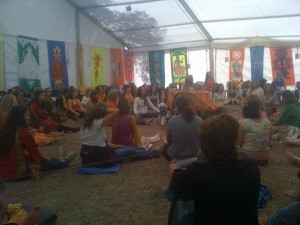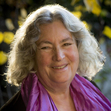Starhawk's Blog, page 6
February 12, 2011
On Egypt
Just over a year ago, I was in Tahrir Square, in Cairo, demonstrating with other members of the Gaza Freedom March, trying without success to pressure the Mubarak's government to let us continue on our humanitarian peace mission to Gaza. In these last weeks, I've often thought about that day on the square—the heady few moments when we blocked traffic, the adrenaline as the police rushed in to beat us back, the long, grueling day on the edge of the square. We took those risks knowing we had some measure of protection, as internationals, from the torture, imprisonment and potential loss of life faced by our Egyptian friends should they take the same kinds of actions.
As I've followed reports of the protests, I've been awed by the spirit, the courage and the stamina of all the people who have come out to take those risks. Yesterday, Mubarak finally yielded to the people's will, and stepped down.
Moments of political euphoria don't come often in a lifetime, and when they do, they are sweet. I wish I could have been back in Tahrir Square to share that celebration, and to honor the sacrifices that so many have made.
As the drama has unfolded, I've been working on a book about power and group process in collaborative groups—with a deadline so tight that, with all my other commitments, it leaves little time for blogging. I've been writing this book because I believe we are entering a new era in which the top-down organizations of governments, corporations and military are more and more being challenged by emergent, collaborative and co-creative movements without traditional lines of authority. I've been working in those kinds of groups for thirty years, and believe I know something of their strengths and pitfalls—if only through the many, many mistakes I've made.
So I've found the unfolding events in Egypt fascinating and affirming—to see a loosely organized movement led by young people rise up, almost without warning, and sweep away the tight control of dictatorship. Because the movement had no Great Leader nor central control, the government had no one whose death or imprisonment could stop the uprising. Because people were voluntarily choosing to participate, they took enormous risks and suffered hardships without faltering. Because they remained committed to nonviolence, they were able to deter the army from extreme reprisals and win over world public opinion.
I wish I knew more about how they made decisions on Tahrir Square, how they communicated in the absence of the internet and those cell-phones we'd come to depend on. I hope that in succeeding days, we'll hear more reports from inside the protestors' camps. I have a deep, professional curiosity about what kind of meetings they had, and how they were facilitated.
And I know that the work of transformation is not done, by any means. Amorphous, emergent movements can be unstoppable—but building a new structure requires some sort of organization. Structures can be washed away by the tides of spontaneous outrage, but to govern a country over time, new structures must be built on a new foundation. The Egyptian people will continue to need our support to make sure the transition is a real one, not just a removal of one face while the infrastructure of oppression remains.
In the meantime, we have much to learn from their experience, and that of the Tunisians and all the other movements arising in the Middle East. Let us all savor this sweet moment, with gratitude to those who bravery, sacrifices and unflagging determination have challenged repression and brought liberation.
December 12, 2010
Save Tasmania's Ancient Forests!

Back in 2004, I had the wonderful privilege of visiting Tasmania for just a few tantalizing days. Activist and forest defender Adam Burling, my host, took me out into the spectacular old growth Eucalyptus forests, magical places of immense trees with an understory of giant ferns. Strange animals that live nowhere else on earth haunt the underbrush, and the silence is primeval.
Permaculture was born in these forests, back in the 1970s when David Holmgren and Bill Mollison were wandering through them, studying their wildlife and biology. They began asking "Why can't we grow food in systems that maintain themselves as forests do?" You can see some shots of the forest that I took in our new documentary, Permaculture: The Growing Edge, directed by Donna Read and me and available at www.belili.org .

Sadly, Tasmania's forests are under attack, like old growth forests in so many places. Although a new forest conservation agreement has been made on paper, roads are still being cut and ancient trees are still falling.
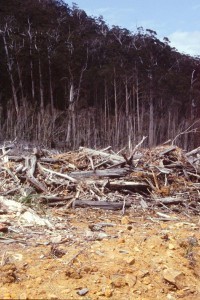
...and if we don't act, we'll have nothing but chipboard.
Tasmanian environmental groups are calling for an international day of action on December 14/15 to pressure the Australian Government to enforce a moratorium on logging the old growth. In Australia and New Zealand, there will be banner hangs and other actions. If you're somewhere else, you can join this effort, as I have, by writing to Tasmania's Premiere David Bartlett and Austrailia's Prime Minister Jullia Gillard to tell them that the world can't wait to see these priceless forests preserved.
You can also join in a night of linked prayer and ritual, on the 14th in the US and Europe, the 15th in Australia. Adam suggests the following intention and imagery:
"FOCUS- to ensure the balance flows towards the protection of the forests and healing for those who feel disenfranchised by the now massive groundswell to protect the forest; the groundswell that has taken many years of hard work by lots of people to achieve. We can use the image of the green wave comming in and healing the land and all who have been involved in making this change. A green wave for the old growth forests of Tasmania and the species they harbour."
Magic and action together make a powerful union!
Here's the links—it's easy to write the letters! Koala bears and Tasmanian devils will thank you! (Okay, my Tasmanian friends inform me that there are no koala bears in Tasmania. But I'm sure they, wherever they are, as forest dwellers, would support this action in solidarity with their Tasmanian counterparts and thank you, nonetheless!)
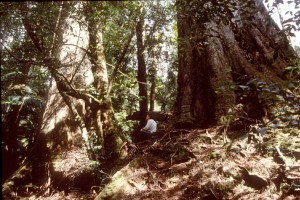
Let's preserve these majestic forests forever!
And here's some more details on the magical activism–from Adam and Australia Reclaiming:
The Australian Reclaiming Community invites you to join us in a national magickal action as part of the International day of Action for Tasmania's Forests.Help us weave a spell to heal and maintain the ecological integrity of Tasmania's wonderful forests.
At 6:30pm on Wednesday 15th December 2010, people around Australia will create their own personal and group rituals to help weave a spell for the forests of Tasmania.
What to do:
Ground and create sacred space, then use drumming, singing, chanting, etc, to raise energy to send out as part of this national spell. The spell's intention is to 'heal and maintain the ecological integrity of Tasmania's forests'. We will use the image of a 'Green Wave' rising up from the ocean, and from underground, surrounding Tasmania (and the rest of Australia) and spreading a deep love for the forests, and an urge to protect their ecological integrity, into the hearts and minds of all Australians.
At the peak of your spell, imagine this green wave of love for the forests spreading throughout the land – as you release the energy you have raised.
Then uncast your Circle and ground, when you have finished.
Feel free to use any song/chant of your choice for the ritual.
I have found an appropriate song by Dana Lyons (of 'Cows With Guns' fame) – that has lyrics that could possibly be worked into the ritual, if anyone is interested.It goes like this:
Prayer For This Land
by Dana LyonsWon't you please hear my prayer for this land
Won't you please hear my prayer for this land
And you know that I'm ready to do my part
I'm just standing by waiting for that wave to startOnly the moon can turn the tide
Only the moon can turn the tide
So I kneel and I pray at the ocean side
And I watch for that wave, that great green wave to riseThere's a sparkle of hope in every eye
There's a sparkle of hope in every eye
And when those eyes sparkle at the same time
That's the time when that wave, that wave of love will rise.Thank you for your support
Regards,
SunBirdP.S. Below is the request for assistance from Adam Burling which prompted this national event. Please take the time to check out the links that Adam has sent through.
hi all,
I'm passing this on in the hope of gaining extra support for the ancient
forests of the isle of Tasmania. This beautiful southern forested
island with its rare creatures, like the Tasmanian Devil and the giant
Wedge-tailed Eagle, has been the subject of widespread clearcut
logging for decades. The logging industry has sued activists,
vigilante logger groups have assaulted protesters, firebombed cars and
threatened to rape tree-sitters.We are at another cross roads now with the potential to end the
destruction of our wildlands. The loggers are in financial crisis and
there is a new political structure with The Green party holding strong
influence over decisions (Tasmania has Australia's first Green
ministers in a minority govt). There is a massive public groundswell
for protection of these giant trees, wild rivers and prehistoric fern
glades. But the loggers want it all, public subsidies and continued
trashing of the forests. We need you help now with this International
Day of Action on Dec 15th. Already we have people from 20 countries
supporting us.Please help, you can send an email of support through
http://www.nativeforest.net, organise your own action or do some
magical support for the forests and the people that work for them.You can also join the facebook group and help spread the word:
http://www.facebook.com/event.php?eid=136438633077930for the forests,
Adam
November 26, 2010
A Recipe for Diversity–or, A Bunch of Diverse Things and a Recipe!
So it's been a rather intense little period of time, this last month and a half. I'm going to post some pictures and hit some of the highlights…
–We held our 31st anniversary Spiral Dance ritual for Samhain/Halloween. It was a powerful and beautiful night, with an amazing spiral and a strong cone of power. One of the highlights for me was our group of teen earth magic-makers, who danced the activist Goddess. Even in rehearsal, when they all marched in with signs and puppets, it brought tears to my eyes.
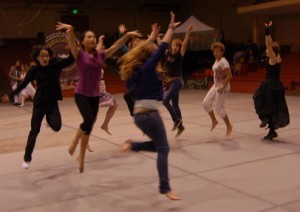
Invoking the Activist Goddess
Tristan Anderson came to the dance. Tristan is an old and dear friend who has been part of building the north altar for many years. In April of 2009 he was shot in the head with a tear-gas canister by an Israeli soldier as he participated in a peaceful demonstration in the Occupied Territories of Palestine. Last year we dedicated healing energy to him—this year, he is finally home, still gravely injured but fighting as hard for his own recovery as he's fought for justice for so many years. The young folks were dancing with shining faces, so filled with energy and fervor, just beginning their own activist journeys. I'm proud of them. I'm glad to know there's a new generation willing to take up the causes I've worked for and fought for—and enraged that they should have to fight battles all over again we though were won, that all our struffles and sacrifices haven't freed them to simply live and enjoy a free, secure, thriving world. I'm afraid of the price some of them may be called to pay. But I know that they are strong and loving and creative and vibrant, and will always have the support of a proud and loving community behind them.
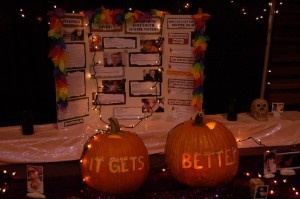
It Gets Better--Altar for the gay teen suicides
So, from the Spiral Dance we jumped into the launch of our new documentary, Permaculture: The Growing Edge, made by me and my dear friend Donna Read who also directed Goddess Remembered, Burning Times and Full Circle. You can see the trailer on our website, www.belili.org. (And order the film, or course—also our earlier documentary on archaeologist Marija Gimbutas, Signs Out of Time.) The launch meant a wild flurry of writing things like press releases and event announcements and website copy and I went through one of those periods where you're constantly sending things out and then realizing you got some important detail wrong. Nonetheless, we had a lovely event and showed the film to great enthusiasm and outright cheers for the chard and collard greens!
And along with those two big events, I started teaching our long-term training program in Bayview Hunters Point, teaching permaculture design and environmental leadership to both garden coordinators and young adults who live in public housing in San Francisco's poorest neighborhood. That's my long term project for this year, and it's exciting and enormously challenging. Exciting because if permaculture and its approach to ecological design are going to really transform the world, we need to bring them into the communities that have the greatest needs and fewest resources. Bayview Hunters Point is a little corner of San Francisco that is amazingly isolated and insular. It's predominantly African-American, and originally many people moved up from the south to work in the naval shipyard. When that closed down in the early 'eighties, crack, drugs and gangs moved in. The navy left a toxic residue—the shipyard is a superfund site and the neighborhood has an infant mortality rate on a par with Bulgaria. Like many inner city areas, it has lots of liquor stores and few if any places to buy fresh food, fruits or vegetables.
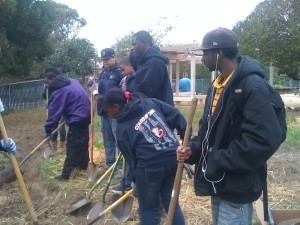
Digging a swale in the garden.
So if we can bring a permaculture vision to the Bayview, we will be reaching far beyond the usual suspects—and to do that, we'll learn a lot about how to address the real and pressing needs of the inner city. We have a great advantage in working with our partner organization, Hunters Point Family, which is deeply rooted in the community. Hunters Point Family runs youth development programs, including violence prevention and job training, and our relationship has built slowly over time. Lena Miller, who directs the organization, is a true visionary who wants to make the Bayview "the green jewel in the crown of the Emerald City."
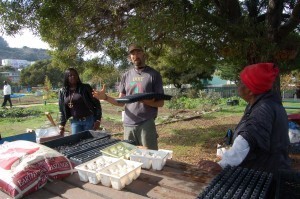
Ben Fahrer teaches us how to make potting soil and plant seeds.
It might be worth a paragraph or two of reflection on how Earth Activist Training gained the trust that allows us to work in this community. I've seen political and social movements struggle for decades with the challenges of working across barriers of race and class—and had my own fair share of personal struggles. But really, it's pretty simple. Or maybe it just seems that way to me now. Permaculture is all about principles—you learn what they are and then apply them. Here's some of my personal principles of diversity work:
1. Be comfortable with who you are. Okay, I know this alone can take some of us a lifetime, but as a start, learn your history, take pride in it, don't try to be some other color or culture or class. Let go of the white guilt or the male guilt or the class guilt. You didn't create those systems of oppression, and while they might offer you certain benefits they also cost you. So just take responsibility for changing them. You, as who you are, have something unique to offer.

Mixing the potting soil...
2. Be of service. Watch, look and listen—find out what the community's aims and challenges and struggles are, and look for ways you can be of service. If you have something to offer—make it known, but wait to be invited in. If you're not invited, you can't just barge in and start doing stuff, however beneficial it might seem to you. Earth Activist Training can only do the work we're doing in the Bayview because we were invited and have a partner in the community. If you are invited, show up and keep showing up. Share skills, resources, information and opportunities.
3. Realize that trust must be earned, and that may take time. Sure, it's painful if people don't instantly like and trust you because you are so nice and sweet and good, but when people have had a history of being exploited and ripped off by other people who look like you, they may not take to you instantly. Don't take it personally, it's not about you. Be comfortable with who you are, be of service and over time you will win that trust. And it will mean a lot more when you do.
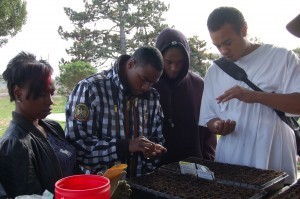
Planting the seeds is a delicate process...
4. When you're in a different culture, norms and values may be different. You might not even realize what your own assumptions are until someone steps all over them. I remember feeling excruciatingly uncomfortable visiting a Sami friend in the north of Norway. I kept trying to make dinner conversation and everything I said dropped into a void of silence. I had just about decided they all hated me, when it occurred to me to ask my friend, "Ellen-Marit, is it like a Sami thing that you don't talk during meals?" "Why would we talk?" she asked. "We're eating!" Watch, look and listen. Expect to learn a lot!
5. Commit to the children. Years ago when I was perplexed about issues of cultural appropriation, I went and meditated and asked for guidance from the ancestors. The ancestors said, "We don't really give a damn who your ancestors were. We care about what you're doing for the children." I would define cultural appropriation as "Taking the gifts of the ancestors without a commitment to their descendents." So—be comfortable with who you are, don't lay claim to knowledge or spiritual teachings or entitlements you haven't earned, and then relax, enjoy, and get on with the work that will benefit the generations to come.
Anyway, those are some of my guidelines. And this post is getting long—so I'm going to stop here and just put up some pictures of our projects. We've dug swales, planted cover crops, onions, garlic and spring bulbs, made a soil mix for seedlings and started seeds, put up a rain catchment system, made compost and sheet mulched. Coming up—forest gardens, windbreaks, taking cuttings and design work.
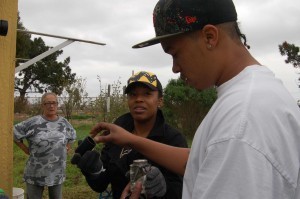
Putting up a rain catchment system.
And we're still trying to fund the program! EAT has been offered a $5000 matching grant—so far we've raised less than half of what we need. If you want to be part of this vital work, everything you give right now will be doubled by our funders. Donate at:
http://earthactivisttraining.org/bayview_project.html
See our video about the project at:
http://www.youtube.com/watch?v=3bdKgBt6LbE
And now, as a thank you for all the generous support we have received, and because so many people on Facebook requested it, I'm going to post here my Thanksgiving Sour Cream Pumpkin Chiffon Pie recipe:
(I got this recipe from a book called The Political Palate put out by a women's collective in Bridgeport, Connecticut who ran a restaurant called Bloodroot back in the 'eighties. I don't know if it's still there. This recipe is from their 1980 edition, when the political part of the palate was all about how fat is a feminist issue and cream is really good for you! Later they became vegans but their pie recipe lives on in my adaptation and blood cholesterol (okay, it's high—but I had my arteries scanned and they are as clear and unclogged as any arteries of a gal my age can be! So there!) Here's how I do it:
1 large organic sugar pie pumpkin.
(Or one sixteen oz. can of organic pumpkin).
1 cup sour cream.
Three eggs.
½ cup sugar (I use the groovy, organic, unprocessed kind like demerara sugar or rapidura. But if you can't get it, bless yourself and say three times, "It's the holidays!") Plus 1/4 cup extra for egg whites.
1 t. cinnamon (good for your blood pressure and cholesterol, helps counteract the cream.)
½ t. ginger. (Good for stomach ailments and nausea.)
¼ t. nutmeg. (Do not, under any circumstances, succumb to the temptation to eat half a cup of it and see if you can get high. You can, but it's no fun, and you won't be able to think straight for days, and you will flunk your final exams and it will be years before you can eat a pumpkin pie again. Don't ask how I know this.)
1/8 t. salt.
1 cup sour cream. (Don't get the low fat stuff—yecch! Why adulterate perfectly good cream by trying to take the fat out of it—the flavor's in the fat. Read Nourishing Traditions and you will find out that butter and cream are indeed actually good for you. Only if you're a devout vegan you can substitute some veganish form of this.)
For topping: 1 1/2 cups of heavy whipping cream, plus 1 1/2T sugar and 1/2 t. vanilla.
Cut up the pumpkin, scrape out the seeds and steam it until soft. (How long would that be? What, am I Julia Child? However long it takes, something between half an hour and an hour and a half. If that's too time-consuming, use the canned stuff.) Puree it in a food processor until it's soft and smooth. If necessary, add just a touch of water. Measure out a cup and half of pumpkin puree.
Separate the eggs. Set the whites aside, and add the yolks, lightly beaten, to the pumpkin.
Add the spices, salt and sour cream and beat together until thoroughly mixed.
Put the mixture in a saucepan and cook gently on the stove until it thickens.
Beat the egg whites into peaks that are stiff but not dry, adding ¼ cup of sugar. Egg whites beat up best when they are at room temperature.
Fold the egg whites into the pumpkin mixture.
Pour it into an unbaked, 9 inch pie shell. (I ladle it in with a soup ladle.)
Back at 375 degrees, 40-45 minutes until firm and brown. Test with a toothpick or knife—push it in and it should come out clear.
Whip 1 ½ cups of cream until stiff and firm, adding 1 ½ T of sugar and ½ t. vanilla. Top the pie with the cream and serve. Mmmmm! Since you're going to all this trouble, I'd double the recipe and make two pies. Freeze one and you'll have it ready to bring to the next potluck!
Enjoy!
Thank you Betsy Beaven, Noel Gordano, Selma Miriam and Pat Shea for the original recipe and many years of pie!
November 3, 2010
The Morning After the Elections
The morning after the elections—I keep thinking of Captain Hans Solo signature line in Star Wars: "I have a bad feeling about this." Actually, I have some profoundly mixed feelings: California, rather than falling into the sea as Edgar Cayce predicted, has been uplifted by our own tectonic forces to perch high and dry above the rising seas of Republican-fueled climatic shifts. We had a string of major victories (not even counting the Giants shutting out Bush's Texas Rangers) for—if not exactly progressives, at least the Forces of Sanity:
We defeated a proposition funded by the oil companies that would have blocked our Climate Change legislation from taking effect—not just by a little, but by about 60% to 40%!
We reversed the policy that has kept our state government hamstrung and kept us locked in bitter budget battles every year. Previously, the state budget required a 2/3 majority to pass. Now we can do it with a simple majority.
Meg Whitman was soundly defeated in her bid for governor, in spite of spending 160 million dollars of her own money. Instead, we got Jerry Brown who has, in recent years, become a centrist Democrat but who did some really great things when he was governor back in the '70s. If the country had followed the environmental course he set then, we would not be in the grave climate change crisis we face today.
Carly Fiorina also failed to buy her way into the Senate. Barbara Boxer retains her Senate seat. Boxer is a good, solid liberal, and while I don't always agree with her stands, I respect her. She's far, far better than the alternative.
Granted, we didn't quite legalize marijuana. Our state's third largest industry will continue, for the present, as a semi-black-market economy. A whole lot of pot growers are privately breathing a sigh of relief. But we got the issue on the ballot as a serious debate, and legalization will eventually come.
On the national scene, of course, not so good. At best we can now hope for gridlock in Washington—but gridlock will be deadly if it continues for the next two crucial years when we face desperate issues environmentally, economically and socially. Worse would be the Republicans actually pushing forward their agenda with the collusion of Democrats who are likely to draw exactly the wrong conclusions from this election.
Already the pundits are trumpeting that the country has moved to the right. In fact, many of us believe the opposite is true—that the country does not really love big corporations, big banks, big weapons manufacturers and warmongers, but is simply disgusted with the lackluster efforts of Democrats and Obama to do anything about them. Given that the Supreme Court opened the floodgates of corporate cash, that the Tea Party has infinite funding by billionaires and huge megaphones like Fox News to amplify its message, it's no surprise that people's rightful anger gets channeled in exactly the wrong directions.
What is the right direction? Below is my own modest plan for fixing the economy, the country and the world.
Invest in life, not death:
Stop spending our money on war and death. Instead, spend it on things that improve peoples' lives and address our grave environmental problems. Create those new, green technologies that will put more people to work. Fund education so young people don't start their lives as debt slaves to college loans. Fund health care. Open up the prison gates and stop incarcerating people at one of the highest rates in the world.
Make the rich pay their fair share:
Raise taxes on those who can afford to pay them. It's obscene that a Meg Whitman has $160 million dollars to spend on a campaign. The rich amass their money using the infrastructures we all pay for—they benefit inordinately and they are required to give very little back. Roll back the tax cuts for the wealthy. If California taxed the rich and the corporations at the rate we did under Reagan, we would not have a budget shortfall today. Is this going to hamper investments and prevent innovation? I don't think so. California under Reagan still did pretty damn well, and people who invent things and start companies didn't exactly wither away from starvation. Will this bring about ultimate social justice and world revolution? No, it's just a modest start in leveling the playing field. But let's start to turn the debate—instead of the mindless "No new taxes!" rhetoric, get those who benefit most from the system to bear their fair share of the burdens.
Hold the real criminals accountable:
Executives who sign off on shoddy safety systems that destroy the ecology of a region, companies that cut corners with cut-rate cement, officials who authorize torture, banks that foreclose on the unemployed with 'sloppy paperwork' read 'fraud', hedge fund managers that do the dirty deals that eat up the pensions of working people—shut them down. Prosecute them—with criminal, not just civil, lawsuits when they deserve it. Put a moratorium on foreclosures.
Get big money out of our elections: Until we do this, until we have true campaign finance reform, those that serve big money will always have a competitive edge over those that challenge the interests of the rich.
I'm sure there are many more points I could add to this agenda but starting with those four would go a long way to fixing things. I invite you to pass them on, agitate for them, rephrase them more eloquently, add your own. Repeat them, over and over again. Remember that the real work of change is always going on—if not in Washington, then in thousands of towns and neighborhoods and communities, if not in the halls of power, then in the streets. Don't be complacent, but don't despair. All around us are allies working for more justice, more freedom, more ecological balance, more peace. This is not a time to fall back, but to step up, to be bolder, braver, louder, funnier, more inventive, more outrageous, more committed. Political winds blow back and forth—hold to your deepest values, and we'll stay the course.
October 12, 2010
Our Global Work Day Actions for 10-10-10
10-10-10 was a Global Work Party day of action against climate change sponsored by 350.org. http://www.350.org/
Here's what my friends and I did:
10-10-10 Diary:
10 AM on 10-10-10—an auspicious moment, if you like the number 10! I am at the Alice Griffith Garden in the Doublerock public housing development in Bayview Hunters Point—a neighborhood of San Francisco sometimes known as a 'food desert'. It's easy to buy a bottle of liquor or a fistful of oblivion here—really hard to get a good, fresh vegetable.
I've been volunteering and working with the gardens and garden coordinators here for the last four or five years, off and on. Earth Activist Training, my own organization, has partnered with Hunters Point Family, which runs youth programs in this predominantly African American neighborhood. Hunters Point Family hires young people to work in the gardens, giving them some income and job skills, and hires local adults from the projects to coordinate the gardens.
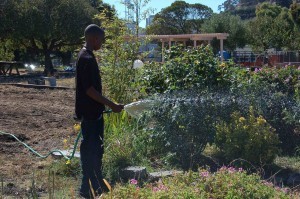
Alice Griffith Garden in the Doublerock Public Housing in Bayview Hunters Point.
We begin by sitting down with the youth—about six of them, and I ask them what they know about climate change and global warming. Turns out that the major thing they know is that President Obama isn't doing a damn thing about it. This does not bode well for the next election cycle—if Obama has lost these kids, well, there's not much base left. Not only that, but I'm told that Michele Obama ain't as cute as she thinks she is. I point out that, whatever you think about Obama's politics, she is definitely cuter than Laura Bush or, shudder, Sarah Palin. We agree upon that. There is, however, a general consensus in the 'hood that the world will indeed end on December 21, 2012. Thought you should know.
Carrying on in spite of impending doom, we set to work—leveling a section of ground where new raised beds will be built. This gives me an excuse to show everyone how to build an A-frame and find level. I'm about to start doing a long-term training program for the garden coordinators in permaculture design, garden management and environmental leadership—and I intend to revisit this lesson again. The simply A-frame is a powerful and ancient tool for finding contours on the land—and finding the contours is the first step toward sculpting the land to retain more water.
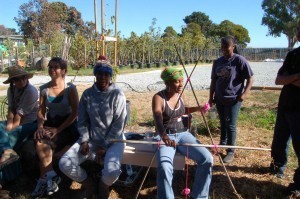
Building an A-frame to find level--an ancient tool!
Miss Jackie, the garden coordinator, has a terrible case of laryngitis and her voice is reduced to a squeak or a whisper. Nonetheless, she keeps offering me potato chips and advice. I counter with strawberries, which she won't eat because she's afraid of inflaming her eczema. Growing food is only half the battle—the other half is getting people to eat it who are now accustomed to junk food. Miss Jackie will eat collards, cabbage and squash—something like chard is out of the comfort zone and why we grow it is a mystery to me. Of course, at home my Goddess-child Kore and visiting granddaughter Tashi are equally resistant to eating vegetables, and both of them have had fresh, organic, deliciously cooked veggies on their plates since birth. Why, if vegetables are so good for us, do human young seem to have an innate resistance to eating them? If there's ever a new stimulus, perhaps we could fund some research into that question.
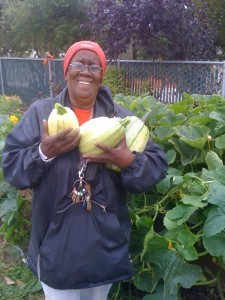
Miss Jackie with a harvest of squash.
Now a few volunteers have arrived, some of our former Earth Activist Training students and a few others who have come over the internet. The boxes meant to go in the space need to be assembled—and there we run into a snag. We have the parts, we have the fasteners—we don't have the tool we need to fasten them. That's my recurring nightmare about hands-on projects—a whole bunch of people standing around for lack of one crucial item. While a few people scrounge through their car trunks for tools, I take the rest of the youth and we unload cardboard and manure that Jason has brought and begin to sheet mulch some of the orchard trees. A few volunteers tackle the weeds. Someone finds a ratchet wrench and Jason, who is a builder by trade, takes the rest over to begin assembling boxes. At our lunch break, we share fresh strawberries and cherry tomatoes picked on site.
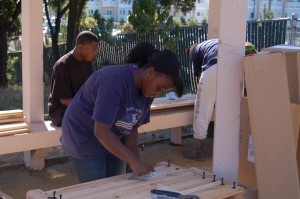
Building the boxes for the new raised beds.
3 pm: By late afternoon, Elaine has arrived with a drill driver, the trees are mulched, the area for the boxes has been rototilled, and the kids are heading home, their work day over. The volunteers stay on long enough to complete three boxes. A great day!
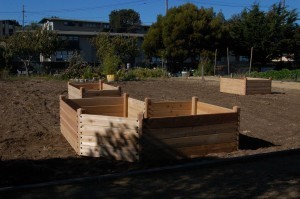
The boxes assembled!
4 pm. A few of us head over to Hayes Valley Farm, a huge garden project built on the site of a former onramp to the freeway demolished after the '89 earthquake. 85,000 tons of mulch later, and it's a sculpted landscape of hills, green and trees where hundreds of volunteers come to help and many programs are offered. We get an enthusiastic tour from Jay Rosenberg, farm manager and one of the visionaries who got city support to turn an ivy-covered ruin into a thriving community garden resource.
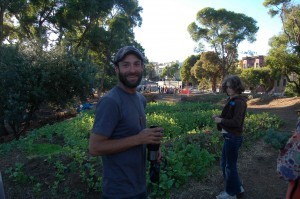
Jay Rosenberg gives us a tour of Hayes Valley Farm.
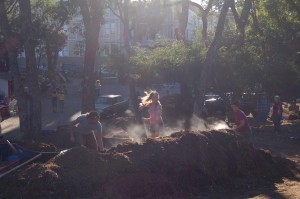
Steaming hot compost!
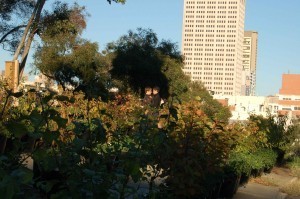
5 pm. Music and food are happening at the farm—but it's time for me to take myself home.
As I leave, I'm feeling a bit more hopeful about the world. I'm thinking about the Doublerock garden. It's in many ways rich and productive—but could be so much more so! The kids who work there are great—but they don't have the manic enthusiasm of these volunteers. Yet! Miss Jackie loves the garden, but she doesn't have the training or skills to manage what is really a small farm. Yet! That's my great hope for our training program. It would be easy to bring in dozens of these enthusiastic, mostly white permies and make the garden flourish—but that would take it away from the community who lives there. That's happened in other places and it is not what we want in the Bayview. What we want is to develop a level of skill and knowledge in the community so they can not only run the gardens but become the next generation of environmental leaders. I don't know if we can really pull that off with our training program, but I'm determined to begin. We still haven't funded the program—but I've gone ahead and turned down other work for the winter and spring, because if I don't create the space for it to happen, it won't. We have a promise of a $5,000 matching grant if we can raise another $5,000. So far, our Facebook Cause page has raised a grand total of $25. This is contributing to my general state of tension.
Will you help raise that other $4,975? If you can kick in even $25, you will have doubled our contributions—think of that! $250—wow, that would be ten times over what we have so far!
Donate online here:
http://www.earthactivisttraining.org/donate.html
And/or join our Facebook Cause where you can also donate at:
http://www.causes.com/causes/529350
Thanks so much! Your support will help change the world!
October 1, 2010
Some Quick Scenes from the Trip
Ooh–it's been a fast and furious few weeks! Hardly even time to check email, let alone write blogs, only intermittent email access–but here's a few highlights and pics if I can get them up before we leave for a fabulous Sicilian lunch and then out to begin the Demeter workshop…
Poland–the first Goddess workshop I've done there, with amazing and wonderful women! We worked with the Baba Yaga stories–and before the workshop, had time for a trip to the most ancient forest in Europe, where wild bison and lynx still roam. Bialosyieva–and I'm sure I'm not spelling that right! Misty forest, sunken pools, old trees, and mushrooms galore! We stayed in a house in the midst of the woods, a family residence grandfathered in to remain where no one is now allowed to build, and feasted on more wild mushrooms than I've ever had–even when they are flush on my own land!
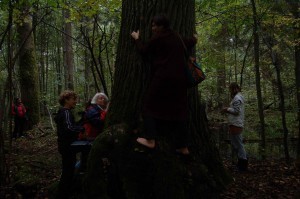
In the ancient forest of Poland...
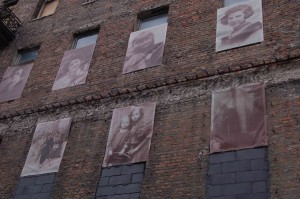
Ghost faces in the remains of the Warsaw ghetto.
Then–a quick trip to England, a talk and spiral dance in the beautiful church of St. James in London, and on to Bristol for two days of work with folks from the Transition Town movement. Good work on group process and decision making–which I will hint to you all, is what my next book will be about! How to make groups of equals work….ever had that problem? Also a wonderful Fall Equinox celebration around a fire in Sarah's back garden, with bicycles whizzing by on the bike path…
And then the Goddess Conference in Madrid–
http://www.conferenciadeladiosa.es/?
So exciting to see the Goddess movement spreading throughout the Mediterranean and Spanish-Speaking world. I got to hand out with Vicki Noble, creator of the Motherpeace Deck and author of important books on the Goddess, like Shakti Woman and The Double Goddess:
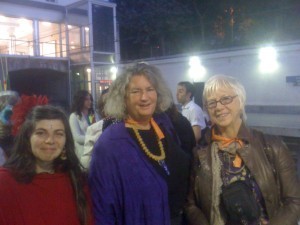
With Vicki Noble and Sandra from Argentina!
And also with Kathy Jones from the Avalon Goddess conference–which together with our Reclaiming tradition was the inspiration for this and much other wonderful work around the world! http://www.goddessconference.com/
At the end, we took the Goddess to the streets with a processon around the statue of Cybele in the center of Madrid:
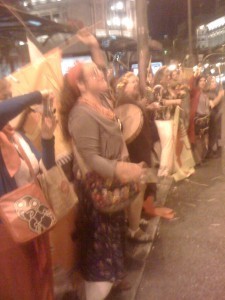
Taking the Goddess to the streets!
And then we had time for some whirlwind tourism around Madrid–a super-quick trip to the beautiful, medieval city of Toledo, and an amazing performance of Flamenco!
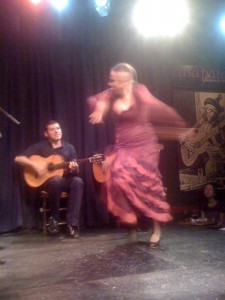
In my next life, I'm going to be a Flamenco dancer!
I've studied it some in this life–but basically, need Remedial Flamenco for the Kinesthetically Impaired–love to watch it, though, and stamp around. Such a powerful image of woman!
And now–Sicily! The island sacred to Demeter–such a gift to be able to celebrate her mysteries here! But first–lunch!
August 21, 2010
Home Again–and On To the Next Adventure!
On To the Next Adventure
I'm home—after a month of intense teaching of our two Earth Activist Trainings—one in Bellingham, one in Vermont, followed by a short vacation with my partner and stepdaughter's family on Martha's Vineyard.
Now—home to San Francisco with visits up to our land in Sonoma County. Most things seem to have survived my absence—although I've finally conceded defeat around ever actually having a summer garden on the land when I'm not there to take care of it. None of the many folks I've had over the years as caretakers ever seem to truly get it as far as the watering regime goes, in spite of my instructions, and at this point I'm just happy if they keep the trees alive. Do I sound bitter? Let's just say I'm shifting my priorities to devote more time to the urban gardens in Bayview Hunters Point, where the squash vines are pumping out produce and where, this winter, I'll be training garden coordinators and youth in permaculture, garden management and skill building.
My most immediate new adventure? Next week I'm taking an exciting course in Aquaponics—the system of integrated fish farms and greenhouses that hold immense promise for urban food production. Last February I visited Growing Power, http://www.growingpower.org/, in Milwaukee, which has pioneered the system on a large-scale inner city farm that produces greens and veggies in the middle of a Midwest snowy winter.
Below is the information on the course—if you're interested, there's still time to sign up! If you scroll down, you'll notice a discount you can get as a friend of Earth Activist Training. I know the course is pricey—but I'm thinking of it as a good investment in skills and knowledge that can help us with the work we're doing in the inner city, to provide both real food security and economic opportunities.
I'll blog about the course, and post some pics.
Next adventure after that? I'll be going to Dandelion, the semi-annual gathering of Reclaiming, my extended spiritual network. We'll have rituals, meetings, workshops—I'll be offering a few and taking more!
http://www.dandeliongathering.org/
And then I'll be off to Europe for a month! Poland—a Goddess Conference in Spain, workshops in England and Sicily—check out the details on:
http://www.starhawk.org/starhawk/schedule.html.
Now—for some hammock time while I have a chance!
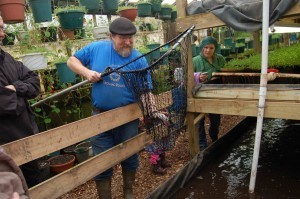
Growing Power greenhouse in Milwaukee
Dear Friend,
Living Mandala and NorCal Aquaponics have a cutting-edge training coming up on new systems of food production for a future of shifting climates and environment stress.
COMMERCIAL AQUAPONICS TRAINING: WITH APPLIED PERMACULTURE DESIGN <http://livingmandala.com/Living_Mandala/Aquaponics_Course.html>
August 25 – 28, 2010
Ukiah, California
Aquaponics combines Aquaculture with Hydroponics creating one of the most sustainable and productive food systems on the planet.
This training is one of a few Commercial Aquaponics Courses available in the country.
What makes this training especially unique as it will also include business coaching as well as permaculture practices focused on closing loops & creating an even more sustainable, dynamic, & regenerative system.
At a time of global climate change, depletion of resources, pollution of water, huge losses of top soil worldwide, and other threats to the future of our food supply, there has never been a more important time to learn about Aquaponics.
The green market potential for Aquaponics is huge and growing fast! Get in on the solutionary action early by attending this course.
We are offering special discounts to this unique training to the permaculture community, affiliate organizations, and PDC grads.
Please forward this to friends and colleagues.
More info below.
-The Living Mandala Team
COMMERCIAL AQUAPONICS TRAINING: WITH APPLIED PERMACULTUR <http://www.eventbrite.com/event/707627533/Aquaponicstraining/5001344046> E DESIGN:
Food for the Future <http://www.eventbrite.com/event/707627533/Aquaponicstraining/5001344046>
August 25 – 28, 2010
Ukiah, California
For More Information Click Here <http://livingmandala.com/Living_Mandala/Aquaponics_Course.html>
Aquaponics Facts
Aquaponics uses up to 90% less water than conventional farming does
Aquaponics is energy efficient: It requires up to 1/3 of the energy other farming systems use.
Aquaponics can have up to 8 to 10 times more vegetable production in the same amount of time and area than conventional gardens or farms.
Labor can be reduced as much as 40%, while useful byproducts are created that can be used to farm other crops, trees, soil, water, and energy.
A permaculture inspired system produces all of the systems needs (water, energy, fish feed, heat, etc.) on-site
Products of the system include: solar electricity, heat, fish, prawns, vegetables, aquatic plants, algae, snails, worms, fertilizer, even methane gas.
Course Description
Aquaponics is one of the most sustainable and productive farming systems in the world. It combines Aquaculture and Hydroponics to create a truly self-sufficient closed loop system that uses only a fraction of the water, labor, energy, etc. that other methods use. Combining Permaculture Design with Aquaponics creates an even more sustainable, dynamic, productive & regenerative system. In this intensive training you will learn some of the most cutting edge pioneering aquaponics systems and gain a solid foundation from which to create your own Aquaponics System, Farm & thriving Green Business.
Permaculture & Aquaponics
Permaculture and Aquaponics focuses truly sustainable closed-loop systems are created that provide all the needs for the system with in the system itself. Max Meyer's focus is on aquapionics systems that that produce virtually all of the system's needs (water, energy, fish, feed, heat, gas, etc.) onsite! Products of the Meyers systems include; Solar electricity, Solar heated air, Solar heated water, fish, prawns, vegetables, fruit, aquatic plants, algae, minnows, snails, worms, dry and liquid fertilizers, even methane gas!
Instructors:
Max Meyers, Hannah Apricot Eckberg, Chris Byrne, and Special Guests
Tuition: Special Discounts for Affiliates & PDC Grads
Regular tuition for this course is $1250. We are offering a special discount of $775 to permaculture design course graduates, and affiliated organizations.
To Register for the PDC Grad Discount Click Here. <http://aquaponicstraining-permies.eventbrite.com>
Earth Activist Promotional Special
Special discount of $375 off course tuition offered to Friends of Earth Activist Training. To register at this special rate enter coupon code: EAT2010
To Register for the Earth Activist Promotional Special Click Here. <http://www.eventbrite.com/event/707627533/Aquaponicstraining/5635347218>
More Information
e-mail:
aquaponics@livingmandala.com
phone: (707) 634-1461
website: www.LivingMandala.com <http://www.LivingMandala.com/>

Heated by compost--Growing Power
June 29, 2010
US Social Forum: Resilience

US Social Forum—Resilience
I'm home now—and how I love my own bed! But it was worth foregoing it for a week to go to the US Social Forum—even though by the last day I saw very little of the meetings or formal process. The best part of these things is always what happens in the hallways—and I was never able to get through the lobby of the Forum without having half a dozen intense and fascinating conversations. But if I sum up what it all meant to me, the theme that emerges is around diversity and resilience.
In nature, diversity of the right degree confers resilience, and I saw that in Detroit. The Forum itself was tremendously diverse, offering us a precious chance both to learn from others' experiences and to recognize that others from all different races and cultures and situations are dealing with the same damn things as we are. And that they might have some new and illuminating approaches that can enrich what we're doing—or even have made some mistakes we can learn from and avoid.
Over the many, many decades I've been a political activist, I've seen many movements overcome huge divides. I remember earnest debates in the 'seventies about whether gay women and straight women could ever really work together in the same organization with any sense of trust. Now, in the days of LGBTQ alphabet soup (lesbian, gay, bisexual, transgender, queer—I suggest we add fluid, uncertain, confused and kookie—check our that acronym!) that's no longer much of an issue.
But the race thing has continued, often, to keep us divided. Too many times I've sat in meetings having the same conversation, over and over again—where are the people of color? The answer is not to go comb the streets, dragging in random people to make our group look more diverse. Nor is it to stop doing what we're doing, if it's the work we're called to. An effective answer involves drawing a bigger circle, like this Forum has done, that includes all of our multiple movements and issues within it as allies, and if we have resources or skills or connections, saying to our brothers and sisters, "We're on the same mission—how can I be of service to you?"
The Forum has allowed me and Lena and Jasmine to hang out a bit in one another's worlds in a way that is actually harder to do at home in San Francisco, where we're entrenched in our responsibilities. We've gotten to meet each others' friends and have time for relaxed conversations. I know that Lena likes her coffee strong and she knows I'm addicted to English Breakfast Tea. Jasmine has confessed that she likes Sex in the City—they know of my inability to tolerate the volume at which hip-hop is performed, and they are willing to sit through at least ten minutes of a Bob Dylan-style folksinger at the Anarchist Convergence. Ultimately, these experiences will put our work together on a stronger foundation.
Resilience—on Saturday Shea Howell from the Boggs Center takes us on a tour of some of the gardens. Detroit is a living example of that old anarchist slogan "Building the new world in the vacant lots of the old." Detroit itself contains a huge expanse of vacant lots, and many of them have been turned into gardens. We see small plots and large expanses, fruit swelling on the trees, tomatoes not yet ripe on the vines, food growing out of the waste.
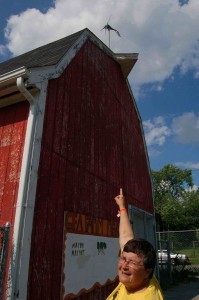
Shea Howell pointing at the wind generator on the barn.
We visit the Catherine Ferguson High School for pregnant teens and teen mothers–with a garden, a farm, a barn and a horse. The girls there learn parenting skills, bring the babies to class, and learn their lessons through gardening and growing food. 97% of them go on to college. The city had the school on the top of its list to close–but the community rallied around and saved it.
Shea takes us to the Heidelberg Project, where artist Tyree Guiton has turned a whole block of devastated houses and lots into a living and ever-changing exhibit of found art: sculptures of scrap metal, houses painted with faces and polka dots, stuffed bunnies hanging crucified on telephone poles, abstract pyramids of old doors, and more. Trash becomes art: resilience!
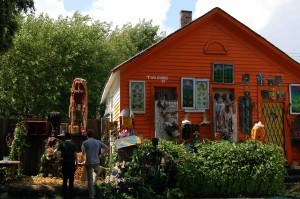
In one vacant lot, the Code Pink women have buried a hummer, and painted it pink. I meet Rae and Medea and Tighe, and hear about their harrowing experiences when they tried to cross the border into Windsor, Canada for lunch. They were stopped—Medea Benjamin has been turned back from Canada before on the grounds of her lengthy arrest record for various acts of civil disobedience—but instead of simply being turned away they were detained for hours, as were two groups who came to support them. Everyone eventually got back, except for Tighe who was held for two nights. When they asked on what grounds he was being held, they were told, "Your government does this all the time. Except instead of holding people for forty-eight hours, you hold them for years."
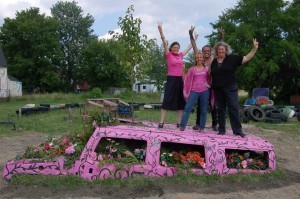
Rae, Medea, Tighe and me.
Another chilling moment—Shea gets a call that someone has disappeared–one of the Latino members of an organization from my own Mission District back in San Francisco. We don't know if he's been picked up by the police or by the immigration police or what—and I still don't know if he's been found.
In Toronto, protestors against the G20 have been rounded up and arrested by the hundreds, beaten and the women threatened with sexual assault. The police violence begins long before a single window is broken—but many windows do get broken and six cop cars are burned. Of course, the hundreds of people arrested are not the ones who broke the windows. I have a lot more to say about this topic—but that will have to wait for a later time—at the very least, until the arrestees are out of jail. Then, maybe, we can discuss whether or not window breaking is strategic. Now, I'm home and the day has begun and I have work to do. So this will be my last post about the Forum.
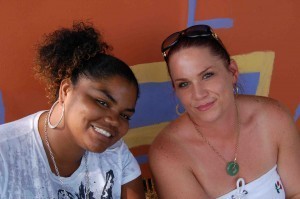
As joyful as the Forum has been, it takes place in the midst of a world daily growing more grim, more controlled and vicious. Uniting across our differences, building this movement is no longer optional—it's necessary if we are to survive. And as we do, the great powers of creativity and resilience become our allies.
June 26, 2010
US Social Forum: A Confession and a Great Day
I confess to you all—I stayed so late at the party last night that I didn't make it up for the 9 AM March for Clean Air. What can I say? I could plead age, or asthma—the march is against the world's largest incinerator, which fills the air with toxic smells—and I've been staving off an asthma attack since I got here. But really I think you should just stop reading now and denounce me. Go ahead. You'll feel better, and so will I.
Okay, now that that's over with, let me give you some highlights of yesterday:
–Our morning workshop on Organizing for the Long Haul, with Grace Lee Boggs, who is ninety-five, and me, and Carlos Alicea Negron, Shea Howell, and Vincent Harding, who worked with Martin Luther King. A great morning hearing some of my own elders talk about what keeps them going. Margo Adair moderated, and talked about her battle with a form of cancer that standard medicine has no cure for. She's used chemotherapy, but also a natural treatment she goes to Canada for—and mostly, the power of mind and visualization and community support. And she looks remarkable well. Her energy has changed, too—Margo and I have known each other for decades, and I've seen her lead many a meditation, but now she has a deepened sense of presence and an openness that strengthens the work. Margo will be at our upcoming Earth Activist Training in Bellingham for part of time, as her energy allows.
–After a too-quick lunch, a second workshop on Vison-Based and Solutions-Based organizing. Me, Margo and Lena anchor this one. We move outside under a shady tree, and talk about vision and story and drama in how we frame our issues. Our time runs short, but something comes clear to me that I've been pondering for a long time about reframing the story around Israel and Palestine—I promise to write more on that soon.
–At the end of the workshop, Shea steals me away for a boat ride. She's got an old inboard/outboard motorboat and we cruise down the river while a couple of the Detroit Summer folks make a music video. The river is blue and cool, the sun is hot, I even get a short nap and come back refreshed just in time for the ritual.
–The challenge with the ritual is finding the space for it—the Canopy village is located on the river but just far enough away that people can't find it. Lots of the political groups simply moved into Cobo Hall and rumors have been floating all week that the canopies were taken down. I resist all suggestions to change the location at the last minute, and somehow over a hundred people find it. We do a simply ritual, making an offering to the land, calling in the elements by asking people who work on issues involving air, fire, water, earth, etc. to come into the center. Grove does a beautiful, simple grounding for us. I lead a short meditation, using an image Shea spoke about in the morning when she described being six years old, and seeing a spiderweb covered with dew illumined by the sun, and suddenly knowing what 'beautiful' meant. We raise energy for the web of connections we have and are creating—like a spiderweb, we don't always see them until the light hits them just right. The forum has been like that light, allowing us to link up with others working on the same issues or facing the same challenges. And like that dew melting back to earth, the energy from those links will flow into solid work and manifest change. We imagine the water flowing, pooling underground, rising through springs to become streams and great rivers, bringing healing to the land and spilling out into the oceans, sending special healing to the Gulf. We dance a spiral, leaving the pattern on the grass, raise a cone of power and ground it back into the earth, and end with gratitude to all we've invoked and to each other.
–By the time we find food and make our way to the party, it's after midnight. The party is spread over a whole street of warehouses, with lots of tables out on the streets and music and dancing inside. All the music is at a volume far too loud for me—my hearing is so bad currently that I simply can't risk any more damage. But Lisa and I enjoy cruising around outside, seeing such a beautiful mix of people filling the space and enjoying themselves. We find Jasmine and Oya, another young woman, sitting at a table and join them. It's a joy just to watch the interactions around me—everyone feeling good, a table of young black kids performing hip-hop, a couple in a long kiss, a mix again of every race and color. Why can't we have this in San Francisco? Why can't we have it everywhere?
June 25, 2010
US Social Forum–An Inspiring Day
US Social Forum: Detroit, Michigan
A short blog today as we have a workshop to give at 10 AM. Some highlights from yesterday:
–Hearing Grace Boggs and Emmanuel Wallerstein, two elders of the movement, in the morning. Most memorable quotes:
Grace: We have to use the negative to advance the positive.
Wallerstein: We want a world that's relatively democratic and relatively equal. I say 'relatively' because nothing is ever perfect.
–Lisa Fithian's workshop in the afternoon. Of course I know Lisa well and work with her all the time but rarely have a chance to just listen to her lay out her approach to organizing, or see slides of some of her union organizing work. I also want my friends from the Bayview to hear her, because we may need to start a new form of organizing to protect our major garden from being bulldozed by developers. Lisa starts off by saying she's tired—but Lisa tired still has twice the energy of any ten ordinary people. No time to say more about the workshop now—but check out her website www.organizingforpower.org for her own notes and lots of resources. A really incredible resource!
–Meeting up with friends and going out to the food booths to grab some quick dinner. Connecting with some of the folks I haven't seen much of from actions long ago.
–Finally meeting my old friend Marta Benevides, who does community organizing in El Salvador. Reclaiming, my extended spiritual network, has had a long term solidarity project to help support her work, ever since she came to a gathering of ours back in the 'nineties. http://www.reclaiming.org/resources/elsal/circleoflove.html
We end up sitting in a circle of chairs near the entrance to Cobo Hall, talking with some of the young people who have been working with Marta. In El Salvador, she's started an Ecohouse and a museum. She works with communities striving to build a culture of peace amidst the growing violence. In El Salvador, as in Mexico, as in the Bayview, the lethal combination of drugs and violence opens the door to even more lethal police violence and intertwined corruption—and in El Salvador it's gotten much, much worse in the last few years.
A couple of the young men are from Williamsburg, Pennsylvania, another community plagued by violence, where a Texas company is planning to move sixty thousand workers in to open up a huge natural gas field. As we sit, one person after another comes by. There's an open chair in the circle and it gets filled over and over again with another amazing person doing great work. My old friend Grove Harris turns up—she has been doing lots of interfaith work and was a major organizer of the World Parliament of Religions.
We go on to Grace Lee Boggs' ninety-fifth birthday party in the ballroom. It's a beautiful tribute to her life and work—and sweet to see how much she is loved and respected. Marta wants to dance—her style of organizing requires much dancing. I remember one great day when I visited her in El Salvador. We were cleaning up and rebuilding a school to be used for technical training. But before we started work, we had a gathering and some of the organizers were honored and given certificates. Then a local band played. After that we put on some music and danced the Macarena. Then we worked—and blasted through a lot in a few hours. Then we had lunch. Then we went to the beach and swam and played in the waves. At the end of the day, I led a ritual. By then we felt we had known each other forever. "If it's not fun, why do it?
Listening to Grace Boggs, connecting with the wonderful people she and her late husband James Boggs collected around them, I am struck by how unafraid they are to talk about love. With all the anger, our own frustrations and the violence we face, they still put love at the heart of their work. So do the other great organizers I know—Marta, and Lisa, and Lena in the Bayview. Anger is real and vital but you can't sustain a life built on anger as its sole foundation. There's a sense of love and joy that permeates this gathering. Very little grumbling—although there are things we could grumble about—and lots of radiant delight. If we can knit these strands into a whole with a unified sense of purpose, what a power we can be!
Today—two workshops and a ritual. Here's the details: all are here in Detroit, Michigan!
Organizing for the Long Haul—10 AM at Woodward Academy room 1470
Grace Boggs is coming to this one—along with Shea Howell, Margo Adair, Carlos Alicea Negron, and Cathy Sanchez!
Vision-Based and Solution-Based Organizing—1 pm at Woodward Academy 1472
myself, Margo, and others.
Full Moon Ritual 8 pm at the Spiritual Healing Space in the Canopy Village—to find it, from Cobo Hall go down to the river, turn right and walk up along the river about six blocks.

